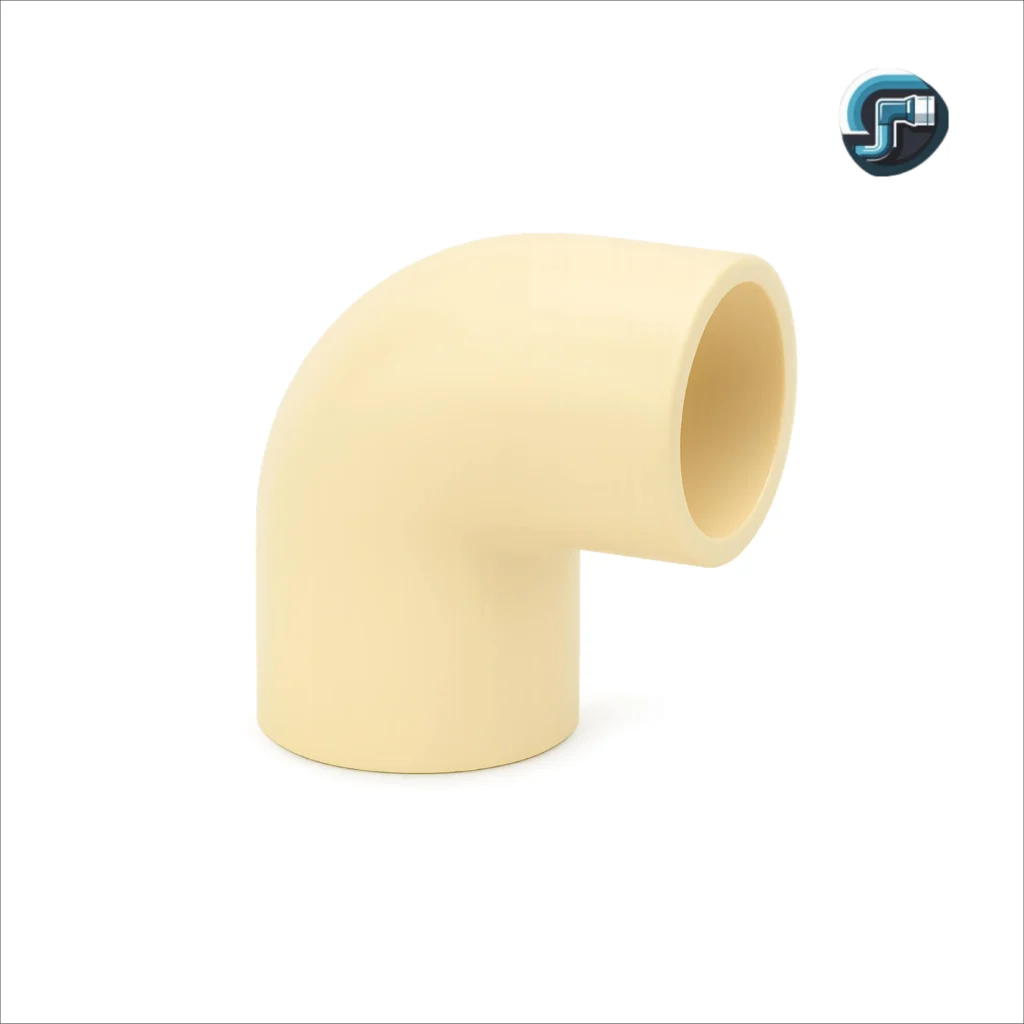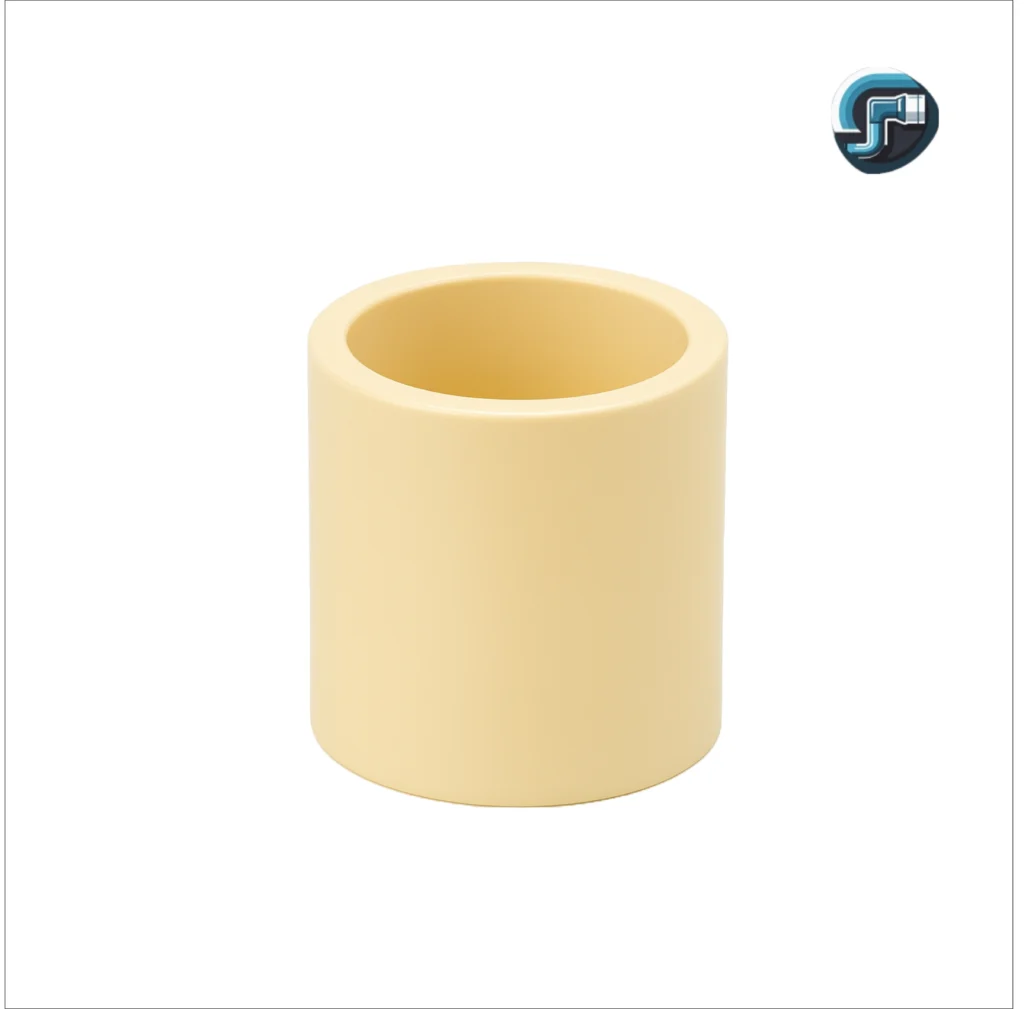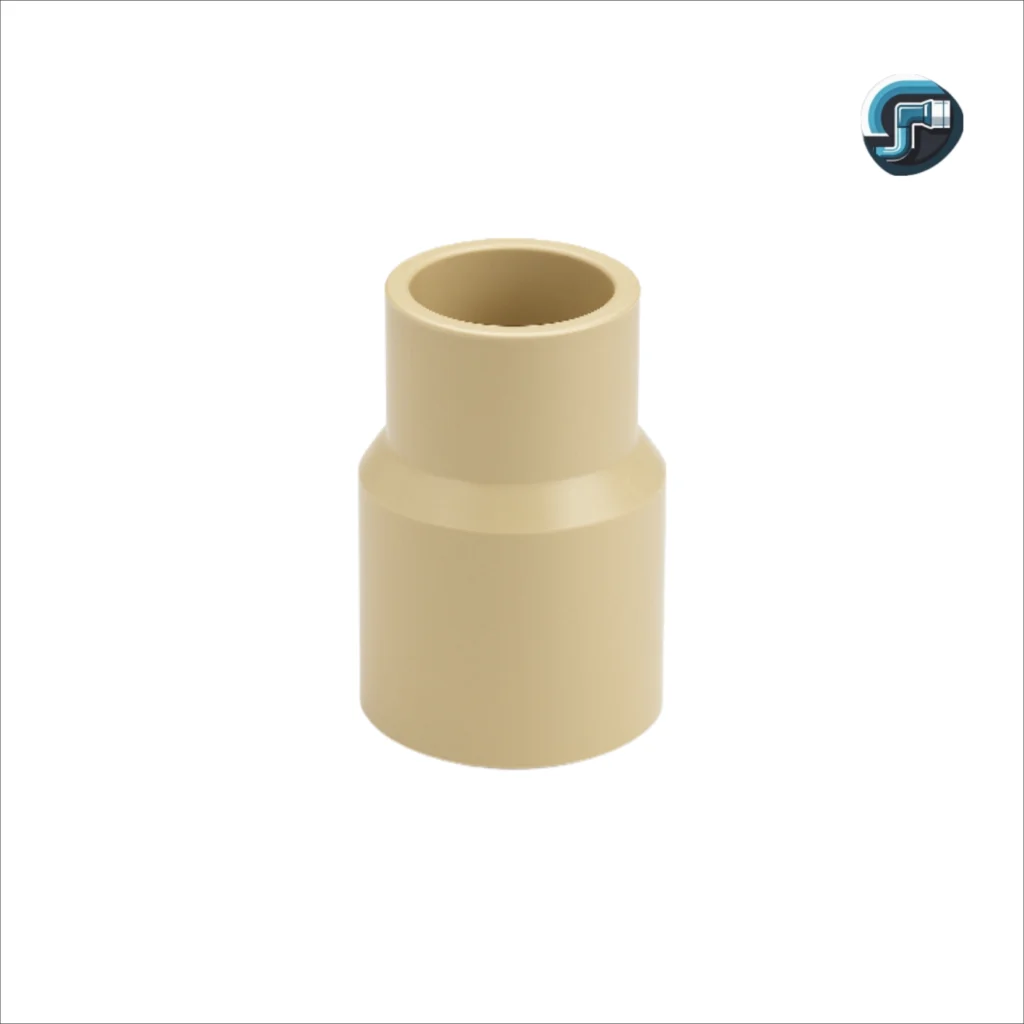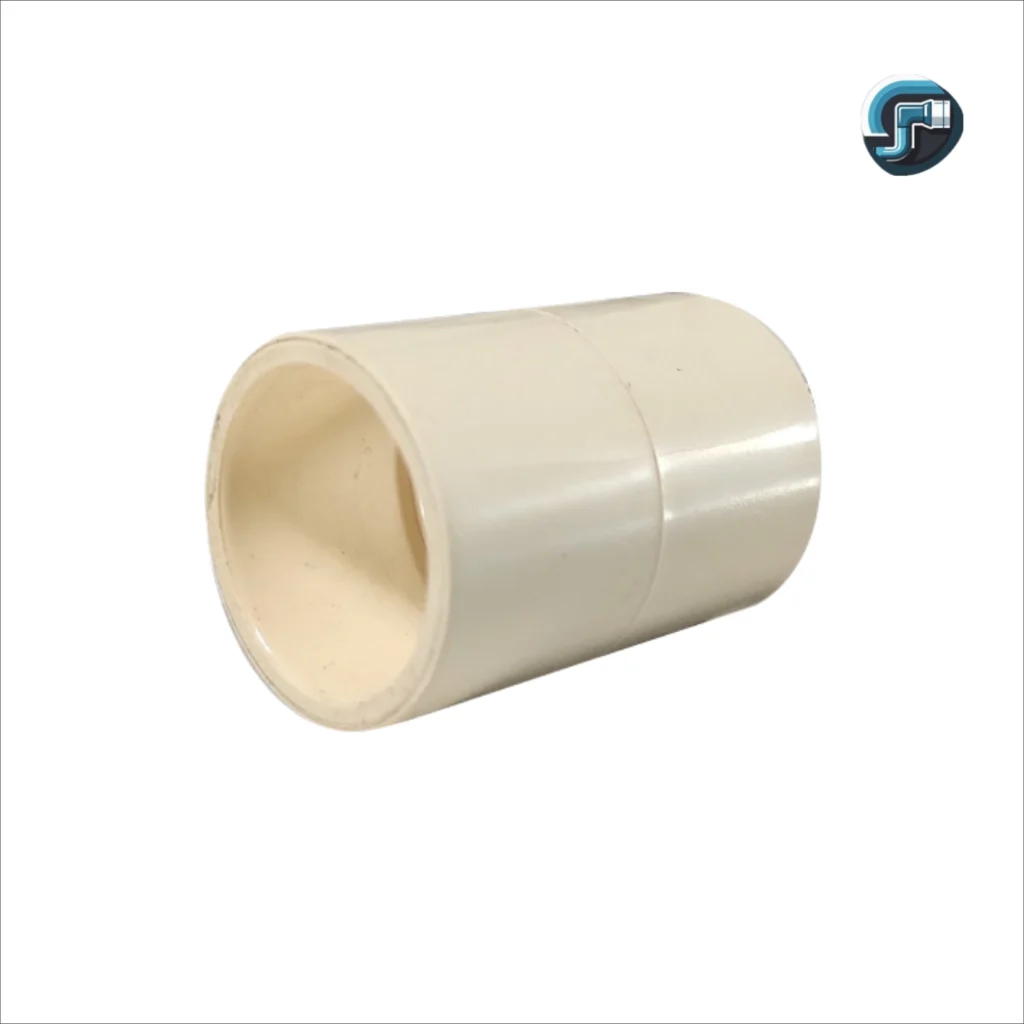These days, Chlorinated Polyvinyl Chloride or CPVC tops the list of materials used for purpose pipes, be it at homes, factories, or offices. The worthiness of this compound is useful when handling hot and cold piping for fire sprinkler systems and chemical processing, as it is of high-strength, rust-free and heat-resistant. CPVC Plumbing fittings are one of the most important components in any CPVC piping system; they help to reinforce the system, smooth the flow, and provide the connection.

What Are CPVC Fittings?
Join CPVC pipe sections; change direction; control flow; and, connect other piping materials: they are meant for all joining or connecting purposes. CPVC is superior to normal PVC in terms of strength and heat resistance. It is applicable in problems of high pressure, and high temperature, so hot and cold water distribution can apply using these fittings.
All CPVC Plumbing fittings are available in a wide variety of sizes and configurations. They are for any pipe size. ASTM specification assures reliability and compatibility in plumbing systems (for instance ASTM D2846 and F441).
Types of CPVC Fittings
CPVC Elbows
CPVC elbows are fittings used to change the direction of flow in a CPVC piping system. They are one of the most commonly used fittings in plumbing, fire sprinkler systems, and industrial liquid handling. Since CPVC can handle high temperatures (up to 93°C / 200°F), elbows are ideal for both hot and cold water supply lines.

CPVC Elbow Sizes Chart
| Elbow Type | Sizes (Inches) | Sizes (mm) |
| 90° Elbow | ½”, ¾”, 1″, 1¼”, 1½”, 2″, 2½”, 3″, 4″ | 15, 20, 25, 32, 40, 50, 65, 80, 100 |
| 45° Elbow | ½”, ¾”, 1″, 1¼”, 1½”, 2″, 2½”, 3″, 4″ | 15, 20, 25, 32, 40, 50, 65, 80, 100 |
| Reducing Elbow (90° / 45°) | ½” × ¾”, ¾” × 1″, 1″ × ½”, 1½” × 1″, 2″ × 1½”, etc. | 15×20, 20×25, 25×15, 40×25, 50×40, etc. |
CPVC Couplings

One of the most widely used fittings in plumbing systems is a CPVC straight coupling, sometimes referred to as a socket coupling. With the aid of CPVC solvent cement, it is intended to join two pipes with the same diameter in a straight line, producing a long-lasting, leak-proof joint.
The CPVC straight coupling is famous for lasting a long time, being able to handle chemicals, corrosion, and scaling, and being able to handle temperatures up to 93°C. This makes it good for both hot and cold water supplies. It’s a good alternative to metal joints that doesn’t cost too much and is easy to install. People often use these couplings to fix and extend pipelines, distribute water for businesses, handle liquids in factories, install fire sprinkler systems, and fix plumbing in homes.
CPVC Coupling Sizes Chart
| Size (inch) | Size (mm) | Type Available |
| ½″ | 15 mm | Straight, Reducing, Socket |
| ¾″ | 20 mm | Straight, Reducing, Socket |
| 1″ | 25 mm | Straight, Reducing, Socket |
| 1¼″ | 32 mm | Straight, Reducing, Socket |
| 1½″ | 40 mm | Straight, Reducing, Socket |
| 2″ | 50 mm | Straight, Reducing, Socket |
| 2½″ | 65 mm | Straight, Reducing, Socket |
| 3″ | 80 mm | Straight, Reducing, Socket |
| 4″ | 100 mm | Straight, Reducing, Socket |
Types of CPVC Couplings
Straight Coupling (Standard Coupling)
A straight CPVC coupling is the simplest and most widely used fitting in CPVC plumbing systems. It is designed to connect two pipes of the same diameter in a straight line, ensuring a secure and leak-proof joint. These couplings are typically available in socket (solvent weld) or threaded variants, depending on whether permanent or detachable connections are required. Straight couplings are durable, resistant to high temperatures and corrosion, and are commonly used in both residential and industrial hot and cold water supply systems. Available in sizes ranging from ½″ to 4″ (15 mm to 100 mm), they provide a reliable solution for extending pipelines or repairing damaged sections with ease.

Reducing Coupling

A reducing CPVC coupling is a special fitting that connects two pipes of different sizes in a straight line. A reducing coupling is different from a straight coupling because it connects pipes of different sizes. This is especially handy when you need to connect a main pipeline to a branch that needs less flow capacity. You can get reducing couplings in socket (solvent weld) and threaded types. They can be used to make permanent or removable joints. They are often used in homes, businesses, and factories because they make sure that flow transitions smoothly, stop leaks, and keep the system running efficiently. Depending on the needs of the pipeline, sizes can be anywhere from ½” × ¾” to 4″ × 3″.
Socket Coupling
The CPVC coupling is a kind of fitting that has plain socket ends. This lets you use solvent cement to connect pipes (the glue method). The pipe fits perfectly into the socket, and when the cement dries, it makes a permanent, leak-proof connection. Socket couplings are often used in plumbing to lengthen pipes, fix broken parts, or connect two pipes in a straight line. They make a stronger bond than threaded joints because they use solvent welding. This makes them perfect for industrial uses, as well as for supplying hot and cold water and fire sprinkler systems. These couplings come in straight socket and reducing socket shapes, and they range in size from ½” to 4″ (15 mm to 100 mm).

CPVC Tees

A CPVC tee is a T-shaped fitting that lets a pipe split into two paths that are at a right angle to each other. It is one of the most common parts used in plumbing and piping systems. It has three openings: one for incoming and two for outgoing (or the other way around). It also comes in different shapes depending on how it will be used. Equal tees, which have three ends that are all the same size, are the most common type. Reducing tees have one or two outlets that are smaller for branching off smaller lines. Threaded tees let you connect to metallic or threaded pipes. Most tees have a socket (solvent weld) design that makes them permanent, but you can also find threaded tees that can be taken apart. A lot of residential plumbing, industrial pipelines, and fire sprinkler systems use CPVC tees. They are tough, last a long time, and can handle high temperatures and rust. They come in sizes from ½” to 4″ (15 mm to 100 mm) to meet different flow needs.
| CPVC Tee Size (inches) | Equivalent Size (mm) | Type Availability (Equal / Reducing) |
| ½ inch | 15 mm | Equal & Reducing |
| ¾ inch | 20 mm | Equal & Reducing |
| 1 inch | 25 mm | Equal & Reducing |
| 1 ¼ inch | 32 mm | Equal & Reducing |
| 1 ½ inch | 40 mm | Equal & Reducing |
| 2 inch | 50 mm | Equal & Reducing |
| 2 ½ inch | 65 mm | Equal & Reducing |
| 3 inch | 80 mm | Equal & Reducing |
| 4 inch | 100 mm | Equal & Reducing |
Equal Tee
Tees are essential fittings in CPVC plumbing systems because they enable pipelines to branch or merge. The Equal Tee is the most popular of these due to its straightforward design and wide range of applications. All three of its outlets, including the branch and the two runs, have the same diameter, giving it a T shape. Without requiring a change in pipe size, this consistent size guarantees that water or fluid flows uniformly in all directions. Either splitting a single line into two identical branches or combining two pipelines into one is how an equal tee operates. For example, you can make two additional 1-inch branches with a 1-inch CPVC pipe by using an equal tee. It is therefore perfect for systems that require uniform and balanced water distribution across a number of outlets. In plumbing, equal tees have a number of advantages. They are robust, long-lasting, and resistant to scaling and corrosion because they are composed of CPVC.
They are appropriate for a variety of applications because they can manage both hot and cold water and withstand temperatures as high as 200°F (93°C). Because of the smooth interior, there is less friction and the water flows smoothly without losing pressure. These fittings are also lightweight, simple to install, and solvent cement-joined for a long-lasting, leak-proof connection. Equal tees are very adaptable in terms of usage. A main water line in a house is divided into branches for the utility rooms, bathrooms, and kitchens. They aid in the uniform distribution of water throughout sizable systems in commercial settings such as hotels, offices, schools, and hospitals. They are also employed in industries where constant flow between system segments is crucial, like factories and plants. Equal tees distribute water evenly to several sprinkler heads for efficient coverage in fire sprinkler systems, which is another common use. Depending on the manufacturer, they are available in diameters ranging from ½ inch to 2 inches, with even larger sizes for industrial applications. Because of this, they can be used for both large-scale industrial piping systems and small-scale residential installations.
CPVC Adapters
Special fittings called CPVC adapters are used to join CPVC pipes to pipes or fittings composed of other materials, like PVC or metal. By serving as transition fittings, they guarantee a leak-proof joining of threaded and non-threaded pipelines. These adapters are frequently used in industrial settings where heat resistance and durability are necessary, as well as in plumbing and hot and cold water distribution.
| Fitting Type | Sizes in Inches | Sizes in mm | Common Variants |
| Couplings | ½, ¾, 1, 1 ¼, 1 ½, 2, 2 ½, 3, 4 | 15, 20, 25, 32, 40, 50, 65, 80, 100 | Straight, Reducing, Socket |
| Tees | ½, ¾, 1, 1 ¼, 1 ½, 2, 2 ½, 3, 4 | 15, 20, 25, 32, 40, 50, 65, 80, 100 | Equal Tee, Reducing Tee |
| Elbows | ½, ¾, 1, 1 ¼, 1 ½, 2, 2 ½, 3, 4 | 15, 20, 25, 32, 40, 50, 65, 80, 100 | 90° Elbow, 45° Elbow, Reducing Elbow |
| Adapters | ½, ¾, 1, 1 ¼, 1 ½, 2, 2 ½, 3, 4 | 15, 20, 25, 32, 40, 50, 65, 80, 100 | MTA, FTA, Reducer Adapter, Brass Threaded Adapter |
| Reducers | ½ × ¾ up to 3 × 2 ½ | 15 × 20 up to 80 × 65 | Coupling Reducer, Bushing Reducer |
| Unions | ½, ¾, 1, 1 ¼, 1 ½, 2 | 15, 20, 25, 32, 40, 50 | Threaded Union, Socket Union |
| End Caps / Plugs | ½, ¾, 1, 1 ¼, 1 ½, 2 | 15, 20, 25, 32, 40, 50 | Socket End Cap, Threaded Plug |
| Valves | ½, ¾, 1, 1 ¼, 1 ½, 2, 2 ½, 3, 4 | 15, 20, 25, 32, 40, 50, 65, 80, 100 | Ball Valve, Check Valve, Gate Valve |
CPVC Male Threaded Adapter
A CPVC Male Threaded Adapter (MTA) is a plumbing fitting used to connect CPVC pipes with components that have female threads. One end of the adapter has a plain socket for solvent welding with CPVC pipes, while the other end features external threads that can be screwed into female-threaded fittings such as valves, taps, or metal connectors. Made from durable and heat-resistant CPVC material, MTAs ensure a strong and leak-proof joint while resisting corrosion, scaling, and chemical reactions.
They are widely used in residential hot and cold water supply systems, irrigation setups, and industrial pipelines where CPVC pipes need to be connected to threaded equipment. Simple to install and reliable in performance, CPVC MTAs play a key role in ensuring safe and efficient plumbing connections. Its mostly used in Connecting CPVC pipelines to valves, taps, or metal fittings with female threads, residential water supply systems (hot and cold water), Frequently used in irrigation systems and plumbing installations.
CPVC Female Threaded Adapter
A CPVC Female Threaded Adapter (FTA) is a piece that connects CPVC pipes to things that have male threads. One end of the adapter has internal (female) threads that let it screw onto male-threaded parts like brass or metal pipes, taps, and valves. The other end has a plain socket that connects to CPVC pipes by melting the two pieces together. FTAs are made of tough, heat-resistant CPVC that won’t rust, scale, or react with chemicals.
They also connect in a way that is safe and won’t leak. They are often used in residential plumbing systems, industrial pipelines, and hot and cold water supply lines where it is necessary to switch between CPVC pipes and threaded fittings. CPVC FTAs are an important part of modern piping systems because they are easy to put together and last a long time.
CPVC Reducer Adapter
A CPVC Reducer Adapter is a special piece of hardware that lets you connect CPVC pipes of different sizes in a piping system. There are two ends, one of which is wider than the other. This makes it simple to join pipes of different sizes. Like other CPVC fittings, the reducer adapter connects to pipes by melting the two pieces together. This makes sure that the link is strong and doesn’t leak. The main job of this is to keep the flow steady while changing the size of pipes in plumbing systems for homes, businesses, and industries. The reducer adapter can work with both hot and cold water supply systems and industrial fluid handling because it is very resistant to heat, corrosion, and chemical reactions. CPVC reducer adapters are very important for making pipeline design and performance better because they let you change the size of pipes without losing strength or durability.
CPVC Brass Threaded Adapter
Both brass and CPVC threads can be used with the sturdy and long-lasting CPVC Brass Threaded Adapter. One side of the adapter features a simple socket that enables solvent joining of CPVC pipes. The brass threads on the other side may be male or female, depending on the application of the adapter. The brass insert strengthens the connection. This suggests that it can tolerate a lot of stress, wear and tear, and frequent tightening and loosening. High-pressure settings, like industrial pipelines and hot/cold water delivery systems, are ideal for these adapters. CPVC pipes and threaded metal components fit together securely and don’t leak thanks to brass threaded CPVC pipe adapters. This suggests that they will last a long time and function effectively in demanding plumbing and industrial settings.
CPVC Unions
A CPVC Union is another fitting that can connect two CPVC pipes, but still allow the two pipes to be unconnected again (as needed). Unlike a coupling (which creates a permanent joint), a union is meant to be used in pipe systems that might require maintenance, inspection, or replacing the pipe or fitting regularly. The union consists of three parts, two end sockets that have CPVC pipes bonded to them with solvent cement and a threaded nut that locks the two parts together along with embedded gaskets in the union.
Unions allow a section of pipe to be removed or reconnected without cutting the pipeline. CPVC unions are also designed for residential plumbing, industrial pipelines, and chemical systems because they are strong, durable, and conveniently allow you to make changes to how piping is configured. CPVC unions come in sizes ranging from ½ inch to 4 inch. Overall, unions will provide a reliable, leak-proof connection that will withstand corrosion, high temperatures, and pressure.
| Nominal Size (inches) | Equivalent Size (mm) | Typical Application |
| ½ inch | 15mm | Household plumbing, small pipelines |
| ¾ inch | 20 mm | Domestic branch lines |
| 1 inch | 25 mm | Medium residential supply lines |
| 1 ¼ inch | 32 mm | Large homes, light commercial use |
| 1 ½ inch | 40 mm | Commercial & industrial setups |
| 2 inch | 50 mm | Main water supply pipelines |
| 2 ½ inch | 65 mm | High-capacity water distribution |
| 3 inch | 80 mm | Industrial and irrigation systems |
| 4 inch | 100 mm | Heavy-duty pipelines & processing plants |
CPVC Valve
A CPVC valve is a control fitting that allows you to stop, start, or let water or other liquids flow in a CPVC piping system. These valves are made from chlorinated polyvinyl chloride, and therefore resistant to heat, rust, and reactions to chemicals; thus they are useful for plumbing in both homes and businesses. CPVC valves are lightweight, easy to assemble, and make a drip-free seal. You can choose from socket( solvent weld) and threaded forms for your application.
Ball Valve
A CPVC ball valve uses a rotating ball with a bore to control the flow of liquid. It is widely used because of its simple operation—just a quarter turn (90°) fully opens or closes the valve. Ideal for quick shut-off applications.
Check Valve
A CPVC check valve allows liquid to flow in only one direction, preventing backflow. It is commonly used in water supply and industrial systems to maintain consistent pressure and protect pumps or equipment.
Gate Valve
A CPVC gate valve uses a sliding gate or wedge to start or stop the flow. It is suitable for applications that require complete shut-off rather than flow regulation.
Butterfly Valve
A CPVC butterfly valve uses a rotating disc to regulate or stop fluid flow. It is lightweight and compact, making it a good choice for larger pipeline systems.
Globe Valve
A CPVC globe valve is designed to regulate flow by moving a disk or plug against the flow path. It is often used when precise control of water flow is needed.
Key Features of CPVC Fittings
- Heat Resistance – CPVC fittings can typically handle temperatures up to 200°F (93°C), making them ideal for hot water lines where PVC would fail.
- Corrosion-Free – Unlike metal fittings, CPVC does not rust, corrode, or scale, ensuring long-lasting performance even in aggressive water conditions.
- Smooth Interior Surface – The fittings allow for efficient flow, reducing friction losses and improving water delivery.
- Chemical Resistance – CPVC fittings resist many chemicals, which is why they are often used in industrial applications.
- Lightweight and Easy to Install – They are significantly lighter than metal alternatives and can be installed with simple solvent cementing methods.
Common Types of CPVC Fittings
There is a wide range of CPVC fittings, each serving a unique function in a plumbing system. Some of the most common include:
- Couplings – Used to join two pipes of the same diameter in a straight line.
- Elbows (90° and 45°) – Allow for changes in direction within the piping system.
- Tees and Crosses – Tees split flow into two directions, while crosses divide it into four.
- Reducers and Bushings – Adapt larger pipes to smaller ones.
- Caps and Plugs – Seal pipe ends either temporarily or permanently.
- Adapters (Male and Female) – Used to connect CPVC pipes to threaded metal or plastic pipes.
- Unions – Allow easy disconnection of pipes for maintenance.
- Valves – Special fittings like CPVC ball valves control water flow within the system.
Applications of CPVC Fittings
- Residential Plumbing – CPVC fittings are widely used in hot and cold water supply lines in homes, ensuring safe delivery of potable water.
- Commercial Buildings – Hotels, hospitals, and office buildings rely on CPVC for reliable water distribution.
- Fire Sprinkler Systems – Due to their high heat resistance and UL/FM approvals, CPVC fittings are trusted in fire protection piping.
- Industrial Use – CPVC fittings are employed in industries where resistance to chemicals and high temperatures is critical.
Installation of CPVC Fittings
One of the major advantages of CPVC fittings is their simple installation process. Unlike metal fittings that require welding or threading, CPVC fittings are joined using solvent cementing. The process involves:
- Cutting the CPVC pipe squarely.
- Cleaning and applying primer (if required).
- Applying solvent cement to both the pipe and the fitting socket.
- Inserting the pipe into the fitting with a quarter-turn to evenly spread the cement.
- Allowing time for curing before pressure testing.
This method ensures leak-proof joints that last for decades if installed correctly.
Advantages of CPVC Fittings Over Alternatives
- Compared to PVC – CPVC fittings handle higher temperatures, making them suitable for hot water lines where PVC cannot perform.
- Compared to Metal – They are immune to rust, lightweight, and more cost-effective while still offering long service life.
- Compared to PEX – CPVC fittings are easier to install without requiring special crimping tools, and they offer better resistance to chlorine degradation.
Frequently Asked Questions (FAQ’s)
Conclusion
CPVC fittings are necessary for modern plumbing and piping systems to work. They last a long time, don’t rust, and can handle high temperatures. Because of this, they are great for homes, businesses, and factories. For systems to work well and be safe, they need CPVC fittings. They move liquids around in factories, bring hot water to homes, and keep buildings from burning down. They are a smart choice for any piping project because they will last for decades if they are installed and maintained correctly.